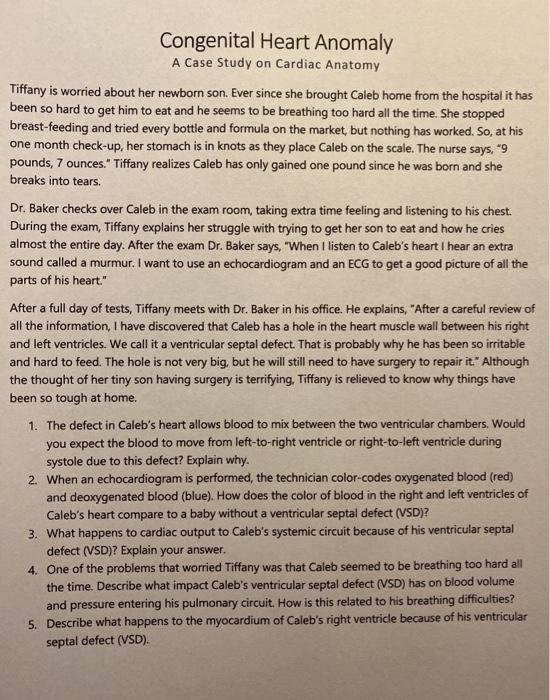
Congenital Heart Anomaly A Case Study on Cardiac Anatomy Tiffany is worried about her newborn son. Ever since she brought Caleb home from the hospital it has been so hard to get him to eat and he seems to be breathing too hard all the time. She stopped breast-feeding and tried every bottle and formula on the market, but nothing has worked. So, at his one month check-up, her stomach is in knots as they place Caleb on the scale. The nurse says, "9 pounds, 7 ounces." Tiffany realizes Caleb has only gained one pound since he was born and she breaks into tears. Dr. Baker checks over Caleb in the exam room, taking extra time feeling and listening to his chest. During the exam, Tiffany explains her struggle with trying to get her son to eat and how he cries almost the entire day. After the exam Dr. Baker says, "When I listen to Caleb's heart I hear an extra sound called a murmur. I want to use an echocardiogram and an ECG to get a good picture of all the parts of his heart." After a full day of tests, Tiffany meets with Dr. Baker in his office. He explains, "After a careful review of all the information, I have discovered that Caleb has a hole in the heart muscle wall between his right and left ventricles. We call it a ventricular septal defect. That is probably why he has been so irritable and hard to feed. The hole is not very big, but he will still need to have surgery to repair it. Although the thought of her tiny son having surgery is terrifying, Tiffany is relieved to know why things have been so tough at home. 1. The defect in Caleb's heart allows blood to mix between the two ventricular chambers. Would you expect the blood to move from left-to-right ventricle or right-to-left ventricle during systole due to this defect? Explain why. 2. When an echocardiogram is performed, the technician color-codes oxygenated blood (red) and deoxygenated blood (blue). How does the color of blood in the right and left ventricles of Caleb's heart compare to a baby without a ventricular septal defect (VSD)? 3. What happens to cardiac output to Caleb's systemic circuit because of his ventricular septal defect (VSD)? Explain your answer. 4. One of the problems that worried Tiffany was that Caleb seemed to be breathing too hard all the time. Describe what impact Caleb's ventricular septal defect (VSD) has on blood volume and pressure entering his pulmonary circuit. How is this related to his breathing difficulties? 5. Describe what happens to the myocardium of Caleb's right ventricle because of his ventricular septal defect (VSD).
没有找到相关结果